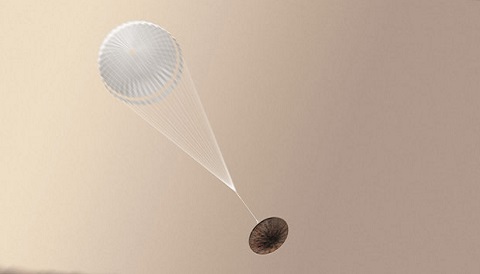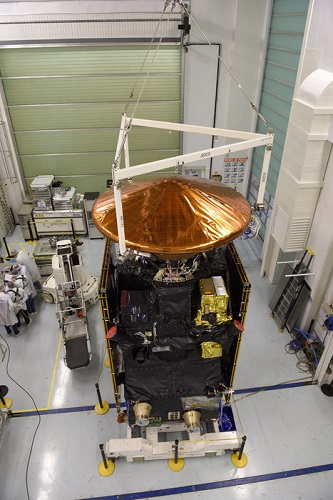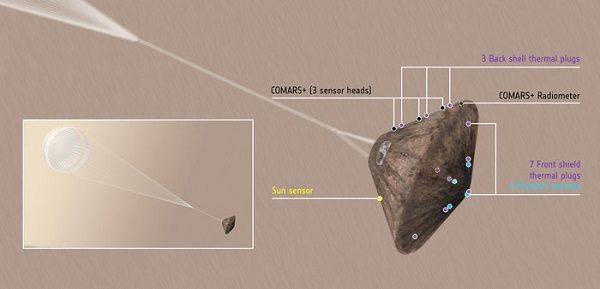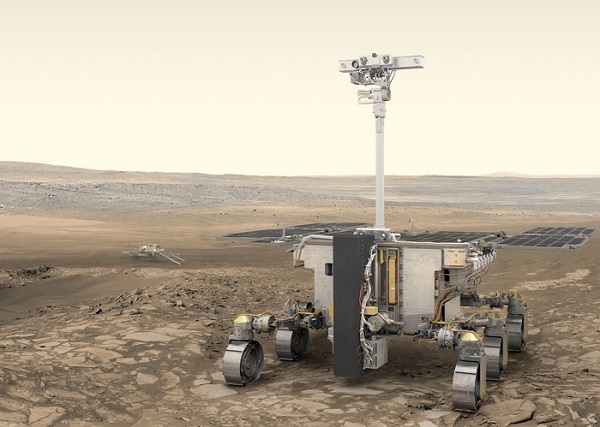The European Space Agency has released its investigation into the crash of the Schiaparelli Mars lander in October 2016.

ESA / ATG MediaLab
Perhaps the loss of one mission will benefit another. A recent independent external inquiry, chaired by the European Space Agency's Inspector General, has shed new light on the fate of ESA's Schiaparelli Lander. A test bed for the full up ExoMars 2020 rover, the lander slammed into the Meridiani Planum landing site at 540 kilometers per hour (340 mph) on October 19, 2016.
Schiaparelli's Journey

ESA / Stephane Corvaja
Named after the 19th century Italian astronomer who mapped the Red Planet, Schiaparelli came heartbreakingly close to a successful landing. Schiaparelli hitched a ride to Mars attached to the ExoMars Trace Gas Orbiter. Both spacecraft launched atop a Roscosmos Proton rocket from the Baikonur Cosmodrome in Kazakhstan, Russia, on March 14, 2016. The plan was for the Schiaparelli Entry, Descent and Landing (EDM) demonstrator to measure atmospheric conditions during and after landing. Schiaparelli was battery-powered (though early plans had called for a nuclear-fueled RTG power supply, like Curiosity) and was set to operate for a few days on the Martian surface.
The Schiaparelli mission featured several attempted firsts: the first time a lander relayed data to its parent ship (TGO) while it was also entering orbit, the first time science data related to dust storm development was collected during descent, and the first lander to feature a deformable underside similar to crumble zones on an automobile to cushion the impact of landing.
Anatomy of an Interplanetary Crash
At first, all went according to plan. Schiaparelli was released from the TGO on October 16, 2016, three days ahead of the scheduled landing. Then, on October 19th, Schiaparelli began its own “six-minutes of terror” as planned: the heat shield protected the spacecraft during initial atmospheric interface, sensors took atmospheric readings, and the parachute deployed on schedule.

ESA / ATG MediaLab
ESA's Mars Express caught Schiaparelli's carrier signal during descent, as did the Giant Metrewave Radio Telescope based in Pune, India.
Problems started about three minutes into atmospheric entry, when Schiaparelli began to spin under its chute. This spin began with parachute inflation, resulting — in the words of the investigation findings — in a “saturation,” exceeding the measurement range of the lander's Inertial Measurement Unit or IMU. This conflict made the lander think it was below ground level, when it was, in fact, still 3.7 kilometers above the Martian surface. The terminal descent phase kicked in, and the lander ejected its backshell and parachute ahead of schedule. To make matters worse, the landing thrusters only fired for 3 seconds, instead of 30 seconds, before falling silent. This put Schiaparelli in a 25-second free fall before slamming into the Martian surface, creating a fresh new Martian crater spied by the Mars Reconnaissance Orbiter weeks later on November 1, 2016.

NASA / JPL-Caltech / University of Arizona
The surface science package, thinking the spacecraft had already landed, relayed one “housekeeping packet” of data during descent before losing contact.
The investigating team noted that the lander impacted very near the anticipated landing site, revealing that the chute and reentry went off very nearly as planned.
The “saturation” of the IMU parameters allowed the team to identify weak spots and possible software fixes, findings that will go a long way towards getting the Mars 2020 rover safely down to the Martian surface.
“The real-time relay of data during the descent was crucial to provide this in-depth analysis of Schiaparelli's fate,” said David Parker (ESA-Human Spaceflight and Robotic Exploration) in a recent press release. “We will take the lessons learned with us as we continue to prepare for the ExoMars 2020 rover and surface platform mission. Landing on Mars is an unforgiving challenge but one we must meet to achieve our ultimate goals.”
Schiaparelli: Paying it Forward
Currently, ESA's Mars Trace Gas Orbiter is working well, and will aerobrake during Mars periapsis for a series of science orbits in 2018. The ExoMars 2020 rover is also on track for a July 2020 launch.

ESA / ATG MediaLab
Space is hard, and if there's one thing the “Great Galactic Ghoul” loves, it's tasty human spacecraft bound for Mars. But the lessons learned from the ESA Schiaparelli EDM landing attempt will be paid forward towards the crucial landing of the ExoMars rover.
 5
5









Comments
Roger Venable
June 4, 2017 at 9:54 am
David --
I'm not sure that I understand your comment that the Schiaparelli lander was the first to collect science data during descent. But let me point out that Viking1 collected mass spectrometer data (for chemical composition of the upper atmosphere) and accelerometer data (to ascertain the density of the upper atmosphere) during descent. Pathfinder also collected accelerometer data during descent. These data were very real, very scientific, and very useful to Earthlings.
Great article. Thanks for such a great report.
-- Roger
You must be logged in to post a comment.
David DickinsonPost Author
June 4, 2017 at 3:44 pm
Hi Roger,
Thanks, I clarified that claim a bit and linked to the source; a statement from ESA ExoMars project scientist Dr. Jorge Vago during an interview last year.
-Dave
You must be logged in to post a comment.
petmar
June 4, 2017 at 11:09 am
David,
I do not completely buy into the explanation as they managed to do this on Titan and must have evaluated the same conditions such as rotation/spin during landing. Can anyone shed light on this?
Marcel
You must be logged in to post a comment.
June 5, 2017 at 9:51 am
Schiaparelli was a 19th century dude by the way, not 18th.
You must be logged in to post a comment.
celeano444
June 5, 2017 at 7:15 pm
Very interesting article... very unfortunate event.
It got me to wondering whether missions such as this have any sort of insurance coverage for mishaps? Do these agencies insure their missions against launch failures, inflight collisions or other catastrophic events? Is it even possible for agencies to obtain insurance? (the premiums would be astronomical... hehehe... pun intended!)
You must be logged in to post a comment.
You must be logged in to post a comment.